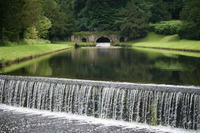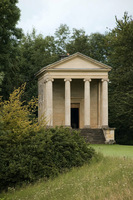Yorkshire is rightly famed for its classic landscape gardens: Castle Howard, Studley Royal, Duncombe and Rievaulx.
 Castle Howard Garden
Castle Howard Garden
Castle Howard Garden »
<p>An eighteenth century palace with park and garden. It has one of the most important examples of the Augustan phase of the Serpentine style. Work on the palatial residence, designed by Vanbrugh, began in 1701. It was theatrically placed on the saddle of a natural ridge. Vanbrugh also designed the mock-fortifications on the southern approach. The Great Avenue was also started. Then, a classical landscape was conceived, on a Roman scale. Charles Howard, Third Earl of Carlisle, was steeped in classical poetry and wished to recreate an ideal world. George London was consulted and, had Howard wished to have 'the Versailles of Yorkshire', an avenue would certainly have been driven into Ray Wood. .....
Read more on Castle Howard Garden
 Studley Royal and Fountains Abbey
Studley Royal and Fountains Abbey
Studley Royal and Fountains Abbey »
This garden was made, by Robert Benson, at an early point in the swing from rectilinear to curvilinear gardens. A formal water garden, owing something to the water parterre at Chantilly, has been set into a wooded valley, creating a balance between the rational and empirical views of nature. The canal and Moon Ponds are overlooked by a Temple of Piety. Gothic and Doric temples are to be found in the woods. At the head of the valley one is astonished to find the noble ruins of Fountains Abbey. The statues of Wrestlers, Hercules and other gods are of Roman inspiration. Studley Royal was designed by its owner, John Aislabie under the influence of John James' translation of the Théorie at .....
Read more on Studley Royal and Fountains Abbey
 Rievaulx Terrace and Temples
Rievaulx Terrace and Temples
Rievaulx Terrace and Temples »
A serpentine grass terrace with an Ionic Temple at one end and a Tuscan Temple at the other.The view of Rievaulx Abbey, made by the Cistercians in the 12th century, is thus 'borrowed' and made part of the garden.
Read more on Rievaulx Terrace and Temples
 Duncombe Park
Duncombe Park
Duncombe Park »
An eighteenth century house (1717), with additions by Sir Charles Barry in 1843. Duncombe Park is well-known to garden historians for its serpentine terrace with fine views. It has an Ionic Temple, by Vanbrugh, at its north end and a Tuscan Temple at its south end. There is a Father Time sundial by van Nost. Barry's forecourt pavilions enclose Italianate nineteenth century parterres.
Read more on Duncombe Park